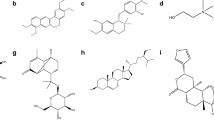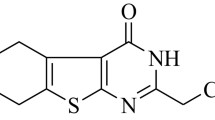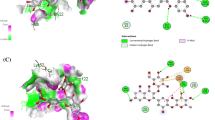Abstract
Psoralea corylifolia L. has been used in traditional Chinese and Ayurvedic medicine systems for management of various diseases. The various phytochemical constituents work in orchestric manner to treat diverse illnesses. Current pharmaco-therapies shown beneficiary role in treatment of dyslipidaemia but facing life threatening side effects. The usage of herbs increased worldwide and paves the way for development of pharmaceuticals for hyperlipidemia treatment. The main objective of present work was to investigate anti-hyperlipidemic activity and in-silico pancreatic lipase inhibitory potential of Psoralea corylifolia L. (PC) leaf extract. The existence of several phytoconstituents was confirmed by the chromatographic research and mainly includes the flavonoids and furanocoumarins. All studied phytoconstituents were found to have superior binding affinity than standard orlistat (− 7.1 kcal/mol), with docking score ranges from − 10.6 to − 7.3 kcal/mol. At 200 mg/kg/day the ethanolic leaf extract demonstrated highest lipid lowering action. Ethanolic leaf extract of Psoralea corylifolia revealed evidential antihyperlipidemic potential in a concentration dependent manner (P < 0.01). The serum lipid profile (LDL, VLDL, TG, TC) dropped firmly and HDL elevated in hyperlipidemic rats treated with plant extract compared with the hyperlipidemic group rats (P < 0.01). The hepatic TC and TG abruptly increased in hyperlipidemic rats and significantly reduced in hyperlipidemic rats administered with EPC compared with the control group (P < 0.01). The hyperlipidemic rats treated with atorvastatin and PC at different doses shown evidentiary increase in secretion of TC and TG compared with the hyperlipidemic group rats. The study results proposed that EPC leaf extract demonstrated noteworthy antihyperlipidemic action. The findings of docking study recommend utilization of the best ligands experimentally to develop novel anti-obesity agents.





Similar content being viewed by others
Abbreviations
- EPC:
-
Ethanolic extract of Psoralea corylifolia L.
- HDLc:
-
High density lipoproteins
- LDLc:
-
Low density lipoproteins
- VLDLc:
-
Very low density lipoproteins
- TC:
-
Total cholesterol
- TG:
-
Triglycerides
- HR-LCMS:
-
High resolution liquid chromatography-mass spectroscopy
- ESI:
-
Electro spray ionization
- EPCL:
-
EPC-Low
- EPCI:
-
EPC-intermediate
- EPCH:
-
EPC-high
- ATV:
-
Atorvastatin
- AI:
-
Atherogenic index
- CAI:
-
Coronary artery index
- CI:
-
Cardiac index
- EDTA:
-
Ethylene-diamine tetra-acetic acid
- OECD:
-
Organization for economic cooperation and development
- CPCSEA:
-
Committee for purpose of control and supervision of experiments on animals
- SGPT:
-
Serum glutamic pyruvic transaminase
- SGOT:
-
Serum glutamic-oxaloacetic transaminase
References
Abegunde DO, Mathers CD, Adam T, Ortegon M, Strong K (2007) The burden and costs of chronic diseases in low-income and middle-income countries. The Lancet 370:1929–1938. https://doi.org/10.1016/S0140-6736(07)61696-1
Adigun NS, Oladiji AT, Ajiboye TO (2016) Antioxidant and anti-hyperlipidemic activity of hydroethanolic seed extract of Aframomum melegueta K. Schum in Triton X-100 induced hyperlipidemic rats. S Afr J Bot 105:324–332. https://doi.org/10.1016/j.sajb.2016.03.015
Ahmed B, Ali Ashfaq U, Mirza MU (2017) Medicinal plant phytochemicals and their inhibitory activities against pancreatic lipase: molecular docking combined with molecular dynamics simulation approach. Nat Prod Res 32(10):1123–1129. https://doi.org/10.1080/14786419.2017.1320786
Birari RB, Bhutani KK (2007) Pancreatic lipase inhibitors from natural sources: unexplored potential. Drug Discov Today 12:879–889. https://doi.org/10.1016/j.drudis.2007.07.024
Bolanle JD, Adetoro KO, Balarabe SA, Adeyemi OO (2014) Hepatocurative potential of Vitex doniana root bark, stem bark and leaves extracts against CCl4-induced liver damage in rats. Asian Pac J Trop Biomed 4(6):480–485
Bouchagra S, Benamia F, Djeghaba Z (2016) Docking studies of (-) Epigallocatechin-3-gallate a potential non-competitive pancreatic Lipase inhibitor. Res J Pharm Biol Chem Sci 7:2493–2505
Chattopadhyaya R, Pathak D, Jindal DP (1996) Antihyperlipidemic Agents A Review Ind Drug 33:85–98
Chopra RN, Chopra IC (1958) Indigenous drugs of India. 2nd ed. Kolkata
Daneschvar HL, Aronson MD, Smetana GW (2016) FDA-approved anti-obesity drugs in the United States. Am J Med 129(8):879-e1-879-e6. https://doi.org/10.1016/j.amjmed.2016.02.009
Egloff MP, Marguet F, Buono G, Verger R, Cambillau C, van Tilbeurgh H (1995) The 2.46 A° resolution structure of the pancreatic lipase-colipase complex inhibited by a C11 alkyl phosphonate. Biochem 34(9):2751–2762
Emimmal MES, Sankar V, Se ME (2019) Synthesis and pancreatic lipase inhibitory activity of phenacyl esters of N-aroyl amino acids. Curr Enzym Inhib 15:133–143. https://doi.org/10.2174/1573408015666190920092114
Gandhi SP, Lokhande KB, Swamy VK, Nanda RK, Chitlange SS (2019) Computational data of phytoconstituents from Hibiscus rosa-sinensis on various anti-obesity targets. Data Brief 24:103994
Getz GS, Reardon CA (2007) Nutrition and cardiovascular disease. Arterioscler Thromb Vasc Biol 27:2499–2506. https://doi.org/10.1161/ATVBAHA.107.155853
Gidwani B, Alaspure RN, Duragkar NJ, Singh V, Rao SP, Shukla SS (2010) Evaluation of a novel herbal formulation in the treatment of eczema with Psoralea corylifolia. Iran J Dermatol 13:122–127
Goldfarb S (1978) Rapid increase in hepatic HMG CoA reductase activity and in vivo cholesterol synthesis after Triton WR 1339 injection. J Lipid Res 19(4):489–494 (PMID: 659987)
Jiang CH, Wang QQ, Wei YJ, Yao N, Wu ZF, Ma YG et al (2015) Cholesterol-lowering effects and potential mechanisms of different polar extracts from Cyclocarya paliurus leave in hyperlipidemic mice. J Ethnopharmacol 176:17–26. https://doi.org/10.1016/j.jep.2015.10.006
Karale PA, Dhawale SC, Karale MA (2022) Quantitative phytochemical profile, antioxidant and lipase inhibitory potential of leaves of Momordica charantia L. and Psoralea corylifolia L. Ind J Pharma Sci 84(1):189–196. https://doi.org/10.36468/pharmaceutical-sciences.910
Khamis AA, Salama AF, Kenawy ME, Mohamed TM (2017) Regulation of hepatic hydroxy methyl glutarate-CoA reductase for controlling hypercholesterolemia in rats. Biomed Pharmacother 95:1242–1250
Khushboo PS, Jadhav VM, Kadam VJ, Sathe NS (2010) Psoralea corylifolia Linn- “Kushtanashini.” Pharmacogn Rev 4:69–76
Kuang W, Zhang X, Lan Z (2017) Flavonoids extracted from Linaria vulgaris protect against hyperlipidemia and hepatic steatosis induced by western-type diet in mice. Arch Pharm Res. https://doi.org/10.1007/s12272-017-0941-y
Li CC, Wang TL, Zhang ZQ, Yang WQ, Wang YF, Chai X et al (2016) Phytochemical and pharmacological studies on the Genus Psoralea: a mini review. Evid Based Complement Alternat Med. https://doi.org/10.1155/2016/8108643
Lichtenstein AH, Appel LJ, Brands M, Carnethon M, Daniels S, Franch HA et al (2006) Diet and lifestyle recommendations revision 2006- a scientific statement from the american heart association nutrition committee. Circulation 114(1):82–96. https://doi.org/10.1161/circulationaha.106.176158
Lowe ME (1997) Structure and function of pancreatic lipase and colipase. Annu Rev Nutr 17:141–158. https://doi.org/10.1146/annurev.nutr.17.1.141
Ma Y, Jiang C, Yao N, Li Y, Wang Q, Fang S et al (2015) Antihyperlipidemic effect of Cyclocarya paliurus (Batal.) extract and inhibition of apolipoprotein B48 overproduction in hyperlipidemic mice. J Ethnopharmacol 166:286–296
Miled N, Canaan S, Dupuis L, Roussel A, Rivière M, Carrière F et al (2000) Digestive lipases: from three-dimensional structure to physiology. Biochimie 82:973–986. https://doi.org/10.1016/s0300-9084(00)01179-2
Miller M (2009) Dyslipidemia and cardiovascular risk: the importance of early prevention. QJM 102(9):657–667. https://doi.org/10.1093/qjmed/hcp065
Mohammad M, Al-Masri IM, Issa A, Khdair A, Bustanji Y (2012) Inhibition of pancreatic lipase by berberine and dihydroberberine: an investigation by docking simulation and experimental validation. Med Chem Res 22:2273–2278
Nadkarni KM (1976) Indian Materia Medica, 3rd ed., vol. I. Popular Prakashan Pvt. Ltd. Mumbai
Nawale S, Padma P, Pranusha P, Ganga RM (2018) Data of antihyperlipidemic activity for methanolic extract of Tagetes patula Linn. flower head along with piperine, as bioavailability enhancer. Data Brief 21:587–597. https://doi.org/10.1016/j.dib.2018.10.022
Oloyede HOB, Bello TO, Ajiboye TO, Salawu MO (2015) Antidiabetic and antidyslipidemic activities of aqueous leaf extracts of Dioscoreophyllum cumminsii (Stapf) Diels in alloxan-induced diabetic rats. J Ethnopharmacol 166:313–322. https://doi.org/10.1016/j.jep.2015.02.049
Panwar U, Singh SK (2019) Identification of Novel Pancreatic Lipase Inhibitors Using In Silico Studies. Endocr Metab Immune Disord Drug Targets 19(4):449–457. https://doi.org/10.2174/1871530319666181128100903
Ren Y, Song X, Tan L, Guo C, Wang M, Liu H et al (2020) A review of the pharmacological properties of psoralen. Front Pharmacol 11:571535. https://doi.org/10.3389/fphar.2020.571535
Ruchel JB, Braun JS, Adefegha SA, Manzoni AG, Abdalla FH, Oliveira JS et al (2016) Guarana (Paullinia cupana) ameliorates memory impairment and modulates acetylcholinesterase activity in Poloxamer-407-induced hyperlipidemia in rat brain. Physiol Behav 168:11–19. https://doi.org/10.1016/j.physbeh.2016.10.003
Sathivel A, Raghavendran HR, Srinivasan P, Devaki T (2008) Anti-peroxidative and anti-hyperlipidemic nature of Ulva lactuca crude polysaccharide on D-galactosamine induced hepatitis in rats. Food Chem Toxicol 46(10):3262–3267. https://doi.org/10.1016/j.fct.2008.07.016
Schurr P, Schultz J, Parkinson T (1972) Triton-induced hyperlipidemia in rats as an animal model for screening hypolipidemic drugs. Lipids 7(1):68–74. https://doi.org/10.1007/bf02531272
Sharma PV (1986) Dravya Guna Vijnana, 1st edn. Chaukhambha Bharati Academy, Varanasi, India
Sodipo OA, Abdulrahman FI, Sandabe UK (2012) Biochemical kidney function with aqueous fruit extract of Solanum macrocarpum Linn. in albino rats chronically administered triton-X to induce hyperlipidemia. J Med Med Sci 3:93–98
The wealth of India, raw materials, vol. VIII. New Delhi: Council of Scientific & Industrial Research; 1969
Thomas A, Allouche M, Basyn F, Brasseur R, Kerfelec B (2005) Role of the lid hydrophobicity pattern in pancreatic lipase activity. J Biol Chem 280(48):40074–40083. https://doi.org/10.1074/jbc.m502123200
Trott O, Olson AJ (2010) AutoDock Vina: improving the speed and accuracy of docking with a new scoring function, efficient optimization, and multithreading. J Comput Chem 31(2):455–461
Wang LQ, Xu N, Zhang JJ, Zhao HJ, Lin L, Jia SH et al (2015) Antihyperlipidemic and hepatoprotective activities of residue polysaccharide from Cordyceps militaris SU-12. Carbohyd Polym 131:355–362. https://doi.org/10.1016/j.carbpol.2015.06.016
Winkler FK, Darcy A, Hunziker W (1990) Structure of human pancreatic lipase. Nature 343:771–774. https://doi.org/10.1038/343771a0
Yang Y, Lowe ME (2000) The open lid mediates pancreatic lipase function. J Lipid Res 41(1):48–57 (PMID: 10627501)
Yusuf PS, Hawken S, Ounpuu S, Dans T, Avezum A, Lanas F et al (2004) Effect of potentially modifiable risk factors associated with myocardial infarction in 52 countries (the INTERHEART study): case-control study. Lancet 364:937–952. https://doi.org/10.1016/s0140-6736(04)17018-9
Zhou K, Xia W, Zhang C, Yu LL (2006) In vitro binding of bile acids and triglycerides by selected chitosan preparations and their physico-chemical properties. LWT-Food Sci Technol 39(10):1087–1092. https://doi.org/10.1016/j.lwt.2005.07.009
Acknowledgements
The authors thank Dr. Priyanka Ingle, scientist of Botanical Survey of India, Pune for providing authentication of plant. Author’s also grateful to Sophisticated Analytical Instrument Facility (SAIF) Office, Indian Institute of Technology, Bombay, Mumbai for providing HR-LCMS characterization of plant extract.
Funding
This research work was financially supported by Chhatrapati Shahu Maharaj Research, Training and Human Development Institute (SARTHI), Pune, Maharashtra, India. The CMSRF- 2019 Fellowship granted to Ms. Pushpa Anantrao Karale.
Author information
Authors and Affiliations
Contributions
PK: Literature search, experimental work, analysis and interpretation of results, rough and revision of draft and approval of manuscript. SD: Supervising and advising the experimental work, preparation and revision of manuscript. MK: Stastical analysis and interpretation of results, manuscript preparation.
Corresponding author
Ethics declarations
Ethics approval
This article does not contain any studies involving human participants performed by any of the authors.
Conflict of interests
Pushpa A. Karale has no conflict of interest. Shashikant C. Dhawale has no conflict of interest. Mahesh A. Karale has no conflict of interest.
Consent to participate
Not applicable.
Additional information
Publisher's Note
Springer Nature remains neutral with regard to jurisdictional claims in published maps and institutional affiliations.
Rights and permissions
Springer Nature or its licensor (e.g. a society or other partner) holds exclusive rights to this article under a publishing agreement with the author(s) or other rightsholder(s); author self-archiving of the accepted manuscript version of this article is solely governed by the terms of such publishing agreement and applicable law.
About this article
Cite this article
Karale, P.A., Dhawale, S.C. & Karale, M.A. In-silico elucidation of phytoconstituents against 1LPB protein and anti-dyslipidaemic activity of Psoralea corylifolia Linn leaf extract. ADV TRADIT MED (ADTM) 23, 1185–1197 (2023). https://doi.org/10.1007/s13596-022-00671-1
Received:
Accepted:
Published:
Issue Date:
DOI: https://doi.org/10.1007/s13596-022-00671-1




